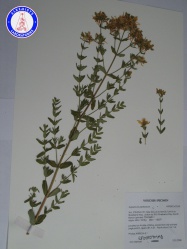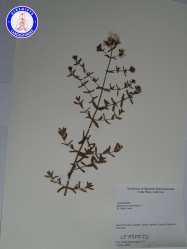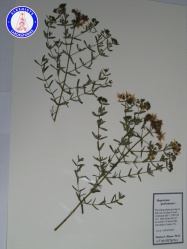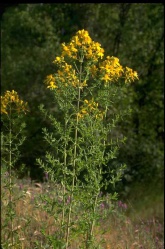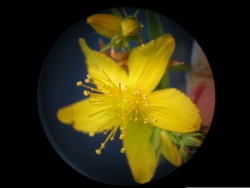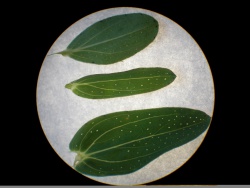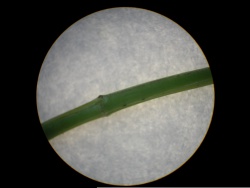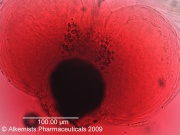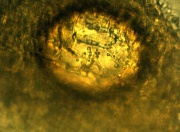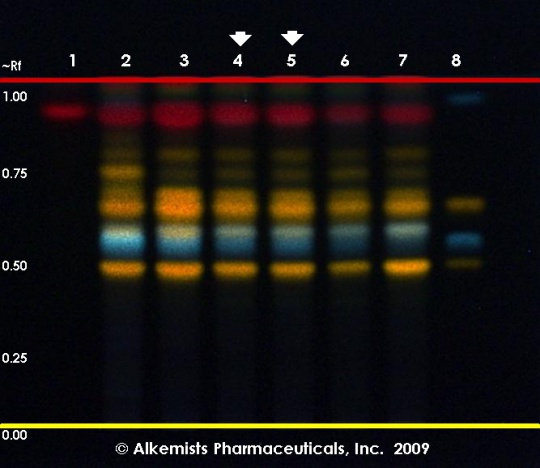Hypericum perforatum (flowering tops)
(new layout (partial) TODO microscopy layout) |
|||
| Line 1: | Line 1: | ||
| − | + | {{DISPLAYTITLE:''Hypericum perforatum'' (flowering tops)}} | |
| − | '' | + | =Nomenclature= |
| − | + | =Botanical Voucher Specimen= | |
| + | {| border=1 | ||
| + | | {{botcon |companyimage= AP-LOGO-Laboratories Crop - Copy.jpg | ||
| + | | companyURL= http://www.alkemist.com}} || {{botcon |companyimage= AP-LOGO-Laboratories Crop - Copy.jpg | ||
| + | | companyURL= http://www.alkemist.com}} || {{botcon |companyimage= AP-LOGO-Laboratories Crop - Copy.jpg | ||
| + | | companyURL= http://www.alkemist.com}} | ||
| + | |- | ||
| + | | {{botimg |mainimage= Hypericum perforatum LF00509MMB A0153.jpg | ||
| + | |source= Botanical Voucher Specimen Library, Alkemists Laboratories http://www.alkemist.com}} | ||
| + | | {{botimg |mainimage= Hypericum perforatum LF19505JD A0154.jpg | ||
| + | |source= Botanical Voucher Specimen Library, Alkemists Laboratories http://www.alkemist.com}} | ||
| + | | {{botimg |mainimage= Hypericum perforatum LF20105BMX1 A0155.jpg | ||
| + | |source= Botanical Voucher Specimen Library, Alkemists Laboratories http://www.alkemist.com}} | ||
| + | |} | ||
| − | + | =Organoleptic Characteristics= | |
| − | '' | + | =Macroscopic Descriptions= |
| − | + | {| border=1 | |
| − | = | + | | {{Macroscopy | source=''Descriptive text includes material derived from Wikipedia, the free encyclopedia (http://en.wikipedia.org/wiki/Hypericum_perforatum, retrieved 02/27/2012) as well as original material.'' |
| − | St John's wort is a perennial plant with extensive, creeping rhizomes. Its stems are erect, branched in the upper section, and can grow to 1 m high. It has opposing, stalkless, narrow, oblong leaves that are 12 mm long or slightly larger. The leaves are yellow-green in color, with transparent dots, which are visible when the leaf is held up to the light, throughout the tissue and occasionally with a few black dots on the lower surface and along the margin. The transparent dots give the leaves a ‘perforated’ appearance, hence the plant's Latin name. | + | | description=St John's wort is a perennial plant with extensive, creeping rhizomes. Its stems are erect, branched in the upper section, and can grow to 1 m high. It has opposing, stalkless, narrow, oblong leaves that are 12 mm long or slightly larger. The leaves are yellow-green in color, with transparent dots, which are visible when the leaf is held up to the light, throughout the tissue and occasionally with a few black dots on the lower surface and along the margin. The transparent dots give the leaves a ‘perforated’ appearance, hence the plant's Latin name. |
Its flowers measure up to 2.5 cm across, have five petals, which are colored bright yellow with conspicuous black dots ''only along the margin'', while the sepals have few or no black dots. The flowers appear in broad cymes at the ends of the upper branches, between late spring and early to mid summer. There are many stamens, which are united at the base into three bundles. Styles are 3, separate to the base. | Its flowers measure up to 2.5 cm across, have five petals, which are colored bright yellow with conspicuous black dots ''only along the margin'', while the sepals have few or no black dots. The flowers appear in broad cymes at the ends of the upper branches, between late spring and early to mid summer. There are many stamens, which are united at the base into three bundles. Styles are 3, separate to the base. | ||
| Line 15: | Line 28: | ||
When flower buds (not the flowers themselves) or seed pods are crushed, a reddish/purple liquid is produced. | When flower buds (not the flowers themselves) or seed pods are crushed, a reddish/purple liquid is produced. | ||
| − | + | ''The quoted text in this section was licensed for use under the Creative Commons ShareAlike License, version 3.0: http://creativecommons.org/licenses/by-sa/3.0/''}} | |
| − | + | ||
| − | + | ||
| − | + | ||
| − | + | ||
| − | + | ||
| − | + | ||
| − | + | ||
| − | + | ||
| − | + | ||
| − | + | ||
| − | + | ||
| − | + | ||
| − | + | ||
| − | + | ||
| − | + | ||
| − | + | ||
| − | + | ||
| − | + | ||
| − | + | ||
| − | + | ||
| − | + | ||
| − | + | ||
| − | + | ||
| − | + | ||
| − | + | ||
| − | + | ||
| − | + | ||
| − | + | ||
| − | + | ||
| − | + | ||
| − | + | ||
| + | {| border=1 | ||
| + | | {{botcon |companyimage= AHPLogoWeb.jpg | ||
| + | | companyURL= http://www.herbal-ahp.org/}} || {{botcon |companyimage= AHPLogoWeb.jpg | ||
| + | | companyURL= http://www.herbal-ahp.org/}} || {{botcon |companyimage= AHPLogoWeb.jpg | ||
| + | | companyURL= http://www.herbal-ahp.org/}} || {{botcon |companyimage= AHPLogoWeb.jpg | ||
| + | | companyURL= http://www.herbal-ahp.org/}} | ||
| + | |- | ||
| + | | {{botimg |mainimage= Hypericum perforatum 1 RU.jpg | ||
| + | |caption1= ''Hypericum perforatum'' growing in the field | ||
| + | |source= Roy Upton, American Herbal Pharmacopoeia® http://www.herbal-ahp.org/}} | ||
| + | | {{botimg |mainimage= Hypericum blossom stereo 2.jpg | ||
| + | |caption1= ''Hypericum perforatum'' flower close-up. Note the black dots on the petals' margin only. | ||
| + | |source= American Herbal Pharmacopoeia® http://www.herbal-ahp.org/}} | ||
| + | | {{botimg |mainimage= Hypericum_perforatum_leaves_stereo_1.JPG | ||
| + | |caption1= ''Hypericum perforatum'' leaves with the characteristic black dots on the margin and translucent dots on the leaf body. | ||
| + | |source= American Herbal Pharmacopoeia® http://www.herbal-ahp.org/}} | ||
| + | | {{botimg |mainimage= Hypericum perforatum stem stereo 2.JPG | ||
| + | |caption1= ''Hypericum perforatum'' stem showing opposite ridges, a defining characteristic of the species. | ||
| + | |source= American Herbal Pharmacopoeia® http://www.herbal-ahp.org/}} | ||
| + | |} | ||
| + | |} | ||
| − | =Microscopic | + | =Microscopic Characteristics= |
{{Microscopy | source=Elan M. Sudberg, Alkemist Laboratories | {{Microscopy | source=Elan M. Sudberg, Alkemist Laboratories | ||
| companyimage= AP-LOGO-Laboratories Crop - Copy.jpg | | companyimage= AP-LOGO-Laboratories Crop - Copy.jpg | ||
| Line 78: | Line 81: | ||
| − | = | + | =High Performance Thin Layer Chromatographic Identification= |
{{HPTLC | source=Elan M. Sudberg, Alkemist Laboratories | {{HPTLC | source=Elan M. Sudberg, Alkemist Laboratories | ||
| description=St. John's Wort (herb) (''Hypericum perforatum'') | | description=St. John's Wort (herb) (''Hypericum perforatum'') | ||
| Line 104: | Line 107: | ||
| }} | | }} | ||
| − | = | + | =Supplementary Information= |
| + | |||
| + | =Sources= | ||
| + | |||
| + | <references /> | ||
| + | [[Category:Botanical]] | ||
Revision as of 19:54, 14 February 2014
Contents |
Nomenclature
Botanical Voucher Specimen
 |
 |
 |
|
|
|
|
Organoleptic Characteristics
Macroscopic Descriptions
|
Microscopic Characteristics
|
|
High Performance Thin Layer Chromatographic Identification
|
St. John's Wort (herb) (Hypericum perforatum) Lane Assignments Lanes, from left to right (Track, Volume, Sample):
Reference materials used here have been authenticated by macroscopic, microscopic &/or TLC studies according to the reference source cited below held at Alkemists Laboratories, Costa Mesa, CA. Stationary Phase Silica gel 60, F254, 10 x 10 cm HPTLC plates Mobile Phase ethyl acetate: Acetic acid: HCOOH: H2O [10/1.1/1.1/2.4] Sample Preparation Method 0.3 g + 3 ml 70% grain EtOH sonicated + heated @ 50° C ~ 1 hr Detection Method Natural Product Reagent + PEG -> UV 365 nm Reference see British Pharmacopoeia, 2003
|
Supplementary Information
Sources
- ↑ Botanical Voucher Specimen Library, Alkemists Laboratories http://www.alkemist.com
- ↑ Botanical Voucher Specimen Library, Alkemists Laboratories http://www.alkemist.com
- ↑ Botanical Voucher Specimen Library, Alkemists Laboratories http://www.alkemist.com
- ↑ Descriptive text includes material derived from Wikipedia, the free encyclopedia (http://en.wikipedia.org/wiki/Hypericum_perforatum, retrieved 02/27/2012) as well as original material.
- ↑ Roy Upton, American Herbal Pharmacopoeia® http://www.herbal-ahp.org/
- ↑ American Herbal Pharmacopoeia® http://www.herbal-ahp.org/
- ↑ American Herbal Pharmacopoeia® http://www.herbal-ahp.org/
- ↑ American Herbal Pharmacopoeia® http://www.herbal-ahp.org/
- ↑ Elan M. Sudberg, Alkemist Laboratories http://www.Alkemist.com
- ↑ Claudia Borst, PhytoLab http://www.phytolab.com/en.html
- ↑ Elan M. Sudberg, Alkemist Laboratories http://www.alkemist.com
